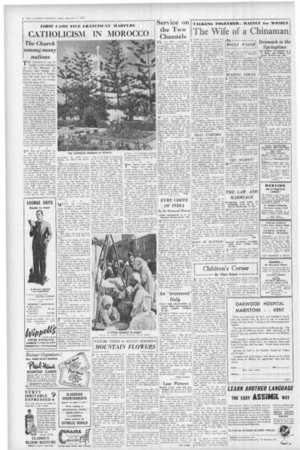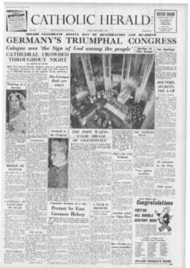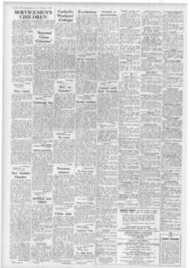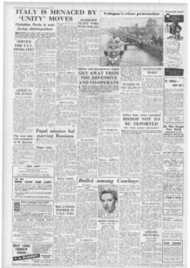Page 6, 7th September 1956
Page 6

Report an error
Noticed an error on this page?If you've noticed an error in this article please click here to report it.
Tags
Share
Related articles
By Archdale A. King
Tolerance Is In The Air Of Tangier
Moorish Cathedral
Shade And Light In Morocco
Anglo Spanish Relations Improved Through Cardinal Hinsley...
The Church !among many nations
THE international city of Tangier is the Cathedral city of the Bishopric of Morocco. But though the Bishop has Jived in Tangier since the early days of this century. only now is a worthy cathedral being built.
The first Christian rnOionaries came to the Empire of Morocco as early as the 13th century. Lhey were five disciples of St. Francis of Assisi. Having been sent by him to Spain, they penetrated as far as Sevilla. In those Jays Sevilla was the capital of one of the Andalucian Moorish kingdoms. and the five friars were soon thrown into prison. Because they wouldn't forswear their faith. the Caliph exiled them to Morocco. 'I here they continued preaching and spreading the new faith. But they were soon arrested again. The Sultan ordered them to be deported. but on the way they escaped, to return again to the Moorish capital and continue preaching. For this they were condemned. tortured and beheaded bs the Sultan himself in 1220.
These five were Morocco's first marts rs and they are reputed to be the first martyrs of the Franciscan Otder: they were killed during the lifetime of St. Francis himself.
THE Holy See established the diocese of Morocco in the sear 1226. For many centuries the Bishops resided at Sevilla, which had been freed from the Moors, and became Auxiliaries of the Archbishops of that diocese. For centuries many Franciscans went to the Empire of the Setting Sun (Al Moghreb el Aksa) and established small missions in various towns These friars did a wonderful work among the many Christian slaves the Barbary pirates were continually capturing. The slaves worked in the fields and in kilns under the burning sun making the thousands of mud bricks that the Sultens used for building their huge rambling palaces and the thick walls that —
surrounded the chief towns, Meknes, Fez, Rabat and Marra
1;eshi Often the missionaries were prevented from helping the prisoners and were imprisoned . and killed. But they shared whenever possible the dungeons and prisons with the slaves and gave them the sacraments and did what they could to alleviate the awful conditions.
Ever since the eighth century. shortly after the invasion of Morocco by the Arabs sweeping across the whole of North Africa, ships were attacked round the coasts of Barbary and Spain, and in the Mediterranean by the Moors, and their crews taken into captivity.
the Franciscans
worked in Morocco, the Order of Mercy founded by St. Peter of Nolasco collected money in Europe for the ransom of the Barbary captives. This order also worked in Morocco. Their ample white habit was chosen so that they could move with greater freedom among the Moors. By 1779 half a million Christian slaves had been ransomed.
This order still exists in Spain and continues to look after the poor.
Then in the middle of the 16th century the Franciscan missionaries were withdrawn from Morocco, and it wasn't until nearly a century later, through the efforts of St. Juan de Prado. a Spanish friar, who was later martyred, that missionaries once more penetrated . into Morocco.
Christians continued to be used as slaves until 1816, when Sultan Mulay Soliman decreed their freedom and with the missionaries the Christians who decided to remain in Morocco, they went to live in the coastal towns.
At the beginning of the 19th century. because of the persecution of the Church in Spain and the forcible closing of all monasteries and convents by the Spanish Government, the missions in Morocco went through another difficult period.
At one time there were so few Franciscans that only one mission was open, in Tangier, and for a time only one friar living there. This friar also acted as Spanish vice-consul.
But the missionary work was never completely interrupted. and towards the end of the last century it began to spread again all over Morocco.
IN 1908 the Holy See once more revived the diocese under Spanish Franciscan Bishops. Then. in 1923, because of the growing European population in the two Protectorates, the diocese was modified. All the French Protectorate of Morocco, the greater part of the country, became the diocese of Rabat, under a French Bishop. The Spanish Protectorate and the International Zone of Tangier remained as the diocese of I Morocco. One of the greatest missionaries was kr. Lerchtindi, who first went over from Spain in 1862. He started many schools and the Spanish hospital built in Tangier. This hospital five years ago was rebuilt in its own grounds and is one of the largest and most modern in the country. The nursing is done chiefly by Franciscan nuns. who have a small convent and a chapel in one wing.
Fr. Larchundi also did much for the poor and started in Tangier the first Spanish-Arabic printing press, as well as many other works.
In the monastery at Tangier are over more than 100 "firrnans" or edicts written by different Sultans to the missionaries. The oldest was written in 1637 by Sultan Mohammed Ex-Xiej authorising one of the Fathers to use two houses near the Moroccan Court for a place of worship. Another is an edict giving one of the missionaries permission to leave the country and re-enter freely and safely through any port.
Other documents are treaties, one dated 1799, between the Sultan and the King of Spain, authorising the free exercise of the Catholic religion in the Empire of Morocco in exchange for the same freedom to be accorded Moslems still living in Spain. This document mentions the gratitude of the Moors for the medical help and charity of the Christian Fathers.
THE International Zone of Tangier, only some 250 square miles, is a port on the Straits of Gibraltar. It is a very cosmopolitan town governed by
the representatives of eight nations, of which Great Britain is one.
There are also British and American colonies here.
The three main religions are Christian, Moslem and Jewish. There is a large colony of Jews. and indeed nearly every town in Morocco has its Jewish quarter.
In Tangier there ale several other Christian denominations. There are 10 Catholic churches and chapels. The largest church is the newly built French Church of Ste. Marie et Ste. Jeanne. served by French Franciscan Fathers. lt can hold a congregation of 2.000 and is built in a style appropriate to the hot climate.
Then there is the Italian Church, for the large Italian colony. much smaller and built in the styleof a country church in Italy. Italian Franciscan Fathers live nearby. Most of thc other churches are served by the Spanish friars.
blog comments powered by Disqus









